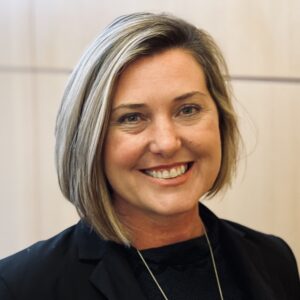The growth of serenity
On the west shore of the Wisconsin River, in the town of Port Edwards, Wisconsin, stands a stately neoclassical brick building surrounded by trees, with a large woodsy sign identifying Edgewater Haven Nursing Home. The facility is the residence of 123 of Wood County's elderly, infirmed, and postoperative citizens. The county-run facility has made many additions and improvements to the original 1928 building over the years, but none have attracted the attention and participation of the community as has the new Serenity Garden.
The Roots
The Edgewater Haven Serenity Garden delights residents, staff, and visitors with flowering trees, shrubs, perennials, and annuals. Conceived by Administrator James Mueller in 2004, the garden occupies an area approximately 85 feet long and 50 feet wide between the main visitor entrance sidewalk and a wing of the building with an existing patio. The facility's goal was to provide an added recreation therapy area that would provide sensory stimulation, punctuate memories not yet lost, and create an atmosphere of peace and well-being in which residents would be inclined to walk or stretch their limbs in response to the surroundings. A beautiful visitor entrance and a garden view from the resident dining room windows are additional benefits of the site.
A team of Edgewater staff, volunteers from the Wood County Master Gardener Association (MGA), and Edgewater Haven Auxiliary members united to plan the Serenity Garden. The group worked through fall and winter 2003 to lay out the project steps, secure funding, obtain quotes for major items, and find volunteer labor. The planning team found many community members—from Edgewater and Port Edwards—willing to pitch in, and each offered their unique talents. Nancy Radlinger of EMR Lawn & Landscaping Services fashioned the wonderful elemental design of the area. MGA volunteer projects included drawing a plan to scale, writing grant requests for funding, and researching the subject of garden therapy and its requirements. Nursing home maintenance personnel took care of concrete quotes, a fence and gate, and electrical supply for the fountain. And the Lincoln High School agriculture department teacher and three students volunteered to build raised beds, plant trees, and install the fountain.
Financial planning commenced with the presentation of the final garden “blueprint” from MGA. Edgewater Haven applied for grants and sought donations from individuals and groups with ties to the community. From the beginning, the goal was to raise adequate finances to create the garden without using facility operational or capital funds. Two local groups, the Community Foundation of South Wood County and the Mead Witter Foundation, granted a combined total of $12,200, and the Port Edwards Business Council, Edgewater Haven Auxiliary, and MGA, along with many individuals, donated the remaining $3,100-plus that made the project's completion feasible.
Planting the Seed
The garden took most of spring and summer 2004 to build, but as work progressed and the quality of the results became apparent, the project seemed to take on a life of its own. Staff, residents' families, MGA volunteers, and local businesses started donating plants, birdbaths, lawn ornaments, decorative pieces, and other items. MGA volunteers tilled in compost, planted, and mulched. By mid-August, a beautiful garden was in use with wide pathways, two patios, six raised beds, three large trees, and a lighted fountain.
Safety precautions included planting nontoxic plants and completely avoiding pesticides. Along a path where plants cascade over a raised bed, flowerless plants that won't attract bees grow to protect residents who might brush against the plants. Gardeners planted many old-fashioned plants—such as peony, iris, and daylily—to remind residents of gardens in their past. One family member thanked the team for planting bridal wreaths. The shrubs, planted to camouflage the fence, remind her mother of the bridal wreath in her home garden and allow her to again enjoy the beautiful show of white flowers in the spring.
As sight and hearing fade for the elderly, the sense of smell can remain strong, so scented plants such as heliotrope, lime basil, pineapple sage, and chocolate mint grow in raised beds. Herbs are scattered throughout the garden and, as sage, thyme, and rosemary are said to possibly stimulate the appetite, they are included in the plantings. Two of the three trees in the garden are Japanese silk lilacs, which provide a heavenly scent throughout the garden. Plants such as sensitive plant (mimosa), obedient plant, and bunny grass are fun to touch. The garden also features aggressive growers, such as ribbon grass or mint, planted in containers or in pots with the bottom cut out.
Cultivating the Benefits
The aptly named Serenity Garden's main purpose is to benefit facility residents. Interdisciplinary experts have widely recognized gardening as a treatment for a multitude of psychological, social, and physical conditions. Now elevated to the clinical level of “horticultural therapy,” gardening offers stimulations to senses dulled by age and illness and brings life and warmth to an impaired person's existence.
Therapy opportunities abound. Speech therapists make use of plant labels in the garden, and residents often try to communicate with volunteers in the garden despite rarely speaking in the hallways. Visual stimulation, physical exercise, and the cognitive therapy of naming familiar plants are some of the first activities provided by the garden. Edgewater's horticultural therapy group has pressed flowers, gathered seeds in fall and planted them in spring, and taken plant cuttings to care for throughout the winter. Other residents simply tour the garden daily to check on the plants. These activities allow the residents to become caregivers, which helps them focus on external issues rather than their own physical challenges.
Themed beds last year “saluted” resident veterans with red, white, and blue plants, and the ladies of the Red Hat Society received “a tip of the hat” with a display of red and purple flora. This year, straw flower, statice, and varieties of celosia planted in one raised bed provide cutting and drying activities for residents in both summer and winter.
Other benefits are perhaps less visible, but documented by research. The annual dormancy and rejuvenation of plants mark time and provide a sense of connection to the earth and to other living organisms. “A garden can restore a sense of order, safety, and privacy for those dealing with the chaos induced by illness,” said Landscape Architect Mark Epstein in a 1998 Seattle Daily Journal of Commerce article. According to Texas A&M researcher Roger Ulrich, simply looking at greenery can reduce stress, lower blood pressure, decrease muscle tension, and increase positive feelings. This benefits residents, family, and staff. The garden can also provide change in a static environment. Different perennials are in bloom from spring through fall. Spring planting is as welcome to residents as a major holiday. Residents visit with family members and sometimes play board games on one of two patios with shaded tables in the garden. The trees and moving water attract birds, and a pair of chipmunks has taken up residence, delighting the residents. Volunteers, tours, and local amateur gardeners bring in the public, adding personal interaction and interest to our residents' lives.
Maintaining Serenity
Garden upkeep for Edgewater maintenance employees consists only of keeping the fountain filled daily and removing the pump and liner for winter; Wood County MGA volunteers do all other maintenance. Soaker hoses, hidden under a heavy layer of mulch, conserve water. The garden has only a few occasional weeds and no grass. Its isolation from grassy areas limits damage from unwanted pests, invasion of grasses, and weed seeds. MGA, the Edgewater Haven Auxiliary, and family donations have provided ongoing funding for purchasing annuals. Serenity Garden is a beautiful area that will serve the therapeutic needs of residents for many years to come.
Edie Behm is Project Leader, Wood County Master Gardener Association, and Brenda Mueller is Treasurer, Edgewater Haven Auxiliary.
For more information, phone (715) 885-8300 or visit https://www.edgewaterhaven.com. To send your comments to the authors and editors, please e-mail behm0907@nursinghomesmagazine.com.
Related Articles
Topics: Articles , Housing











